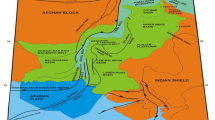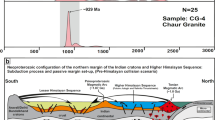Abstract
The distribution of oil and gas accumulations in the Hamada oil pool is strongly influenced by the structural architecture of the study area. An analysis was undertaken to appraise the effectiveness of using the current remote sensing data and deep seismic reflection profiles to evaluate both the surface and subsurface structures of the Hamada oil pool on the western part of Libya. In order to understand the evolution of the southeast Ghadames Basin during Palaeozoic times, the integration of log correlation, seismic interpretation and remote sensing analysis was carried out. The main goal of the remote sensing study was the determination of the structural features of the Qarqaf Arch. The Ghadames Basin and the Al Qarqaf Arch are very large scale, hundreds of kilometres and extremely low-relief “lithospheric waves” of the Saharan Platform. Kilometric to metric folds and faults, which are second-order structures of much lesser scale, affect this basically flat area, providing the required structural complication for the traps to be formed. The main structures detectable in the subsurface by seismic interpretation are normal faults affecting the basement and dividing it into horst and graben systems and positive inversion structures, consisting of compressional gentle folds associated with reverse faults located on the pre-existing normal faults. The extensional movement switched into a compressional one. Deep-seated, flower-like fault systems that are probably transpressional faults were recognised.









































Similar content being viewed by others
References
Abadi AM, van Wees J-D, van Dijk PM, Cloetingh SA (2008) Tectonics and subsidence evolution of the Sirt Basin, Libya. AAPG Bull 92:993–1027
Abohajar A, Krooss B, Harouda M, Littke R (2009) Maturity and source‐rock potential of mesozoic and palaeozoic sediments, Jifarah Basin, New Libya. J Pet Geol 32:327–341
Al-Husseini M (2000) Origin of the arabian plate structures: amar collision and Najd Rift. Geoarabia-Manama 5:527–542
Alexeyev E (1985) Sheet Habayt al Ghardaqah NH 33-9, Geological Map of Libya, scale 1:250000 explanatory. Industrial Research Center, Tripoli
Belhaj F (1996) Palaeozoic and Mesozoic stratigraphy of eastern Ghadames and western Sirt basins. Geol Sirt Basin 1:57–96
Boote DR, Clark-Lowes DD, Traut MW (1998) Palaeozoic petroleum systems of North Africa. Geol Soc Lond, Spec Publ 132:7–68
Cochran MD, Petersen LE (2001) Hydrocarbon exploration in the Berkine Basin, Grand Erg Oriental, Algeria, Chapter 26. AAPG Memoir 74
Daniels R, Emme J (1995) Petroleum system model, eastern Algeria, from source rock to accumulation: when, where and how. Proceedings of the seminar on source rocks and hydrocarbon habitat in Tunisia, pp. 101–124
Dardour A, Boote D, Baird A (2004) Stratigraphic controls on Palaeozoic petroleum systems, Ghadames basin, Libya. J Pet Geol 27:141–162
Demirkesen A (2008) Digital terrain analysis using Landsat‐7 ETM + imagery and SRTM DEM: a case study of Nevsehir province (Cappadocia), Turkey. Int J Remote Sens 29:4173–4188
Echikh K (1998) Geology and hydrocarbon occurrences in the Ghadames basin, Algeria, Tunisia, Libya. Geol Soc Lond, Spec Publ 132:109–129
Elfigih OB (2002) Regional diagenesis and its relation to facies change in the upper Silurian, lower Acacus formation, Hamada (Ghadames) Basin, northwestern Libya. Doctoral (PhD) thesis, Memorial University of Newfoundland
Futyan, A., and Jawzi, A.H., 1996, The hydrocarbon habitat of the oil and gas fields of North Africa with emphasis on the Sirt Basin, in Salem, M.J., El-Hawat, A.S., and Sbeta, A.M., eds., The geology of Sirt Basin: Amsterdam, Elsevier, v. II, p. 287–308.
Gabtni H, Jallouli C, Mickus K, Zouari H, Turki M (2006) The location and nature of the Telemzan High–Ghadames basin boundary in southern Tunisia based on gravity and magnetic anomalies. J Afr Earth Sci 44:303–313
Ganas A, Pavlides S, Karastathis V (2005) DEM-based morphometry of range-front escarpments in Attica, central Greece, and its relation to fault slip rates. Geomorphology 65:301–319
Goudarzi GH (1980) Structure—Libya. Geol Libya 3:879–892
Guiraud R, Bellion Y, Benkhelil J, Moreau C (1987) Post‐Hercynian tectonics in Northern and Western Africa. Geol J 22:433–466
Gundobin V (1985) Geological Map of Libya Sheet NH-33 (Qararat al Marar) and explanatory booklet. Industrial Research Centre, Tripoli
Hallett D (2002) Petroleum geology of Libya. Elsevier, Amsterdam
Hamyouni E, Amr I, Riani M, El-Ghull A, Rahomer S (1991) Petroleum source rock evaluation and timing of hydrocarbon generation. A case study. Geology of Libya, Murzuk Basin, Libya, pp 183–211
Hooper DM, Bursik MI, Webb FH (2003) Application of high-resolution, interferometric DEMs to geomorphic studies of fault scarps, Fish Lake Valley, Nevada–California, USA. Remote Sens Environ 84:255–267
Husseini MI (1989) Tectonic and deposition model of late Precambrian-Cambrian Arabian and adjoining plates. AAPG Bull 73:1117–1131
Jurak I (1978) Sheet Jabal al Hasawna NH 33-14, Geological Map of Libya, scale 1:250000, Explanatory Booklet. Industrial Research Center, Triboli
Klett TR (2000) Total Petroleum Systems of the Trias/Ghadames Province, Algeria, Tunisia, and Libya–the Tanezzuft-Oued Mya, Tanezzuft-Melrhir, and Tanezzuft-Ghadames. US Department of the Interior, US Geological Survey
Klitzsch E (1969) Die Strukturgeschichte der Zentralsahara: neue Erkenntnisse zum Bau und zur Paläogeographie eines Tafellandes
Klitzsch E (1971) The structural development of parts of North Africa since Cambrian time, Symposium on the geology of Libya, Tripoli, Faculty of Sciences, University of Libya, pp 256–260
Kruseman G, Floeghel H (1980) Hydrogeology of the Jifarah, NW Libya. In: Salem MJ, Busrewil MT (eds) Second Symposium on the Geology of Libya. Academic Press, London 2, 763–777
Leech D, Treloar P, Lucas N, Grocott J (2003) Landsat TM analysis of fracture patterns: a case study from the Coastal Cordillera of northern Chile. Int J Remote Sens 24:3709–3726
Lüning S, Archer R, Craig J, Loydell D (2003) The Lower Silurian ‘hot shales’ and ‘double hot shales’ in North Africa and Arabia. The geology of northwest Libya (Ghadames, Jifarah, Tarabulus and Sabratah basins): Tripoli. Earth Sci Soc of Libya 3:91–105
Lüning S, Craig J, Loydell D, Štorch P, Fitches B (2000) Lower Silurianhot shales' in North Africa and Arabia: regional distribution and depositional model. Earth Sci Rev 49:121–200
Corporation M (1992) Exploration geology and geophysics of Libya. Oklahoma, Masera Corporation, Tulsa, 205
Masoud A, Koike K (2006) Tectonic architecture through Landsat-7 ETM+/SRTM DEM-derived lineaments and relationship to the hydrogeologic setting in Siwa region, NW Egypt. J Afr Earth Sci 45:467–477
Montgomery S (1994) Ghadames basin and surrounding areas: structure in tectonics, geochemistry and field summaries. Pet Front 10:79
Montgomery S, Cheney T, Cain D (1993) Ghadames Basin of north central Africa. Stratigraphy, geologic history, and drilling summary. Petroleum Frontiers 10:51
Parizek A, Keen L, Rohlich P (1984) Sheet Idri (NG 33-1), Geological Map of Libya, scale 1:250,000, Explanatory Booklet, Industrial Research
Peña SA, Abdelsalam MG (2006) Orbital remote sensing for geological mapping in southern Tunisia: implication for oil and gas exploration. J Afr Earth Sci 44:203–219
Rusk DC (2001) Libya, petroleum potential of the underexplored basin centers—a twenty-first-century challenge, Chapter 22. AAPG Memoir 74
Saadi NM, Aboud E, Watanabe K (2009) Integration of DEM, ETM+, geologic, and magnetic data for geological investigations in the Jifara Plain, Libya. IEEE Transac 47:3389–3398
Saadi, N.M., Watanabe, K., 2008. Lineaments extraction and analysis in Eljufra area, Libya. Journal of Applied Remote Sensing 2, 023538-023538-023516.
Saadi NM, Zaher MA, El-Baz F, Watanabe K (2011) Integrated remote sensing data utilization for investigating structural and tectonic history of the Ghadames Basin, Libya. Int J Appl Earth Obser Geoinform 13:778–791
Said FM (1974) Sedimentary history of the Paleozoic rocks of the Ghadames Basin in Libyan Arab Republic. University of South Carolina, Geology
Sander N (1968) The Premesozoic structural evolution of the Mediterranean region, geology and archaeology of northern Cyrenaica, Libya: Petroleum Explor. Soc. Libya 10th Ann. Field Conf. Guidebook, pp 47–70
Seidl K, Rohlich P (1984) Sheet Sabha NG 33-2, Geological Map of Libya, scale 1: 250000, Explanatory Booklet. Industrial Research Center, Triboli
Shah S, Mansouri A, El Ghoul M (1993) Palaeozoic sandstone reservoirs of the Hamadabasin, Nw Libya: effects of synsedimentary processes on porosity. J Pet Geol 16:345–352
Sinha S (1980) On the application of geophysical logging in the assessment of ground-water potential in Al Hamada al Hamra Basin. In: Salem M, Busrewil MT (eds) Second Symposium on the Geology of Libya. Academic Press, London, p 643
Thurmond AK, Abdelsalam MG, Thurmond JB (2006) Optical-radar-DEM remote sensing data integration for geological mapping in the Afar Depression, Ethiopia. J Afr Earth Sci 44:119–134
Underdown R, Redfern J, Lisker F (2007) Constraining the burial history of the Ghadames Basin, North Africa: an integrated analysis using sonic velocities, vitrinite reflectance data and apatite fission track ages. Basin Res 19:557–578
Van de Weerd A, Ware P (1994) A review of the East Algerian Sahara oil and gas province (Triassic. Ghadames and Illizi Basins), First Break, 12
Van Der Meer F, Cloetingh S (1993) Intraplate stresses and the subsidence history of the Sirt Basin (Libya). Tectonophysics 226:37–58
Yassaghi A (2006) Integration of Landsat imagery interpretation and geomagentic data on verification of deep‐seated transverse fault lineaments in SE Zagros, Iran. Int J Remote Sens 27:4529–4544
Ziegler PA, Cloetingh S, vanWees J-D (1995) Dynamics of intra-plate compressional deformation: the Alpine foreland and other examples. Tectonophysics 252:7–22
Acknowledgements
The author is grateful to the two reviewers and the editor for the time and effort they put into their detailed comments that helped improve this paper. The author would like to express their gratitude and acknowledgements to Arabic Gulf Company of Petroleum for providing the data used in this manuscript.
Author information
Authors and Affiliations
Corresponding author
Rights and permissions
About this article
Cite this article
Abudeif, A.M. Seismotectonic analysis of Hamada oil pool, Libya, using Landsat and seismic data. Arab J Geosci 8, 6811–6834 (2015). https://doi.org/10.1007/s12517-014-1700-8
Received:
Accepted:
Published:
Issue Date:
DOI: https://doi.org/10.1007/s12517-014-1700-8




